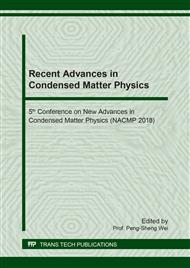[1]
R.Bandyopadhyay, J. Selbo, G. E. Amidon and M. Hawley, Application of Powder X-ray Diffraction in Studying the Compaction Behavior of Bulk Pharmaceutical Powders, J. Pharm. Sci. 94 (2005) 2520–2530.
DOI: 10.1002/jps.20415
Google Scholar
[2]
T. Feng, R. Pinal and M. T. Carvajal, Process Induced Disorder in Crystalline Materials:Differentiating Defective Crystals from the Amorphous Form of Griseofulvin, J. Pharm. Sci. 97 (2008) 3207–3221.
DOI: 10.1002/jps.21219
Google Scholar
[3]
I. Tho and A. Bauer-Brandl, Quality by design (QbD) approaches for the compression step of tableting, Expert Opin. Drug Deliv. 8 (2011) 1631–1644.
DOI: 10.1517/17425247.2011.633506
Google Scholar
[4]
N. K. Thakral, S. Mohapatra, G. A. Stephenson and R. Suryanarayanan, Compression-Induced Crystallization of Amorphous Indomethacin in Tablets: Characterization of Spatial Heterogeneity by Two-Dimensional X-ray Diffractometry, Mol. Pharm. 12 (2015).
DOI: 10.1021/mp5005788
Google Scholar
[5]
M. Morita and S. Hirota, Estimation of the Degree of Crystallinity and the Disorder Parameter in a Drug by an X-Ray Diffraction Method with a Single Sample, Chem. Pharm. Bull. (Tokyo) 30 (1982) 3288–3296.
DOI: 10.1248/cpb.30.3288
Google Scholar
[6]
M. Otsuka, F. Kato and Y. Matsuda, Comparative evaluation of the degree of indomethacin crystallinity by chemoinfometrical fourie-transformed near-infrared spectroscopy and conventional powder X-ray diffractiometry, AAPS PharmSci 2 (2000) 80–87.
DOI: 10.1208/ps020109
Google Scholar
[7]
K. Nikowitz, A. Domján, K. Pintye-Hódi and G. Regdon, Multivariate calibration of the degree of crystallinity in intact pellets by X-ray powder diffraction, Int. J. Pharm. 502 (2016) 107–116.
DOI: 10.1016/j.ijpharm.2016.02.018
Google Scholar
[8]
P. Kommavarapu, A. Maruthapillai, R. Allada, K. Palanisamy and P. Chappa, Simultaneous estimation of degree of crystallinity in combination drug product of abacavir, lamivudine and neverapine using X-ray powder diffraction technique, J. Young Pharm. 5 (2013).
DOI: 10.1016/j.jyp.2013.10.003
Google Scholar
[9]
M. Colombo, S. Orthmann, M. Bellini, S. Staufenbiel and R. Bodmeier, Influence of Drug Brittleness, Nanomilling Time, and Freeze-Drying on the Crystallinity of Poorly Water-Soluble Drugs and Its Implications for Solubility Enhancement, AAPS PharmSciTech 18 (2017).
DOI: 10.1208/s12249-017-0722-4
Google Scholar
[10]
T. D. Davis, K. R. Morris, H. Huang, G. E. Peck, J. G. Stowell, B. J. Eisenhauer, J. L. Hilden, D. Gibson and S. R. Byrn, In situ Monitoring of Wet Granulation Using Online X-Ray Powder Diffraction, Pharm. Res. 20 (2003) 1851–1857.
DOI: 10.1023/b:pham.0000003385.20030.9a
Google Scholar
[11]
E. Räsänen, J. Rantanen, A. Jørgensen, M. Karjalainen, T. Paakkari and J. Yliruusi, Novel identification of pseudopolymorphic changes of theophylline during wet granulation using near infrared spectroscopy, J. Pharm. Sci. 90 (2001) 389–396.
DOI: 10.1002/1520-6017(200103)90:3<389::aid-jps13>3.0.co;2-9
Google Scholar
[12]
J. C. Anthes, H. Gilchrest, C. Richard, S. Eckel, D. Hesk, R. E. West, S. M. Williams, S. Greenfeder, M. Billah, W. Kreutner and R. E. Egan, Biochemical characterization of desloratadine, a potent antagonist of the human histamine H(1) receptor, Eur. J. Pharmacol. 449 (2002).
DOI: 10.1016/s0014-2999(02)02049-6
Google Scholar
[13]
A. Ainurofiq, R. Mauludin, D. Mudhakir and S. N. Soewandhi, Synthesis, characterization, and stability study of desloratadine multicomponent crystal formation, Res. Pharm. Sci. 13 (2018) 93–102.
DOI: 10.4103/1735-5362.223775
Google Scholar
[14]
A. Ainurofiq, R. Mauludin, D. Mudhakir, D. Umeda, S. N. Soewandhi, O. D. Putra and E. Yonemochi, Improving mechanical properties of desloratadine via multicomponent crystal formation, Eur. J. Pharm. Sci. 111 (2018) 65–72.
DOI: 10.1016/j.ejps.2017.09.035
Google Scholar
[15]
S.-Y. Chang and C. C. Sun, Superior Plasticity and Tabletability of Theophylline Monohydrate, Mol. Pharm. 14 (2017) 2047–(2055).
DOI: 10.1021/acs.molpharmaceut.7b00124
Google Scholar
[16]
S. Bhadra and D. Khastgir, Determination of crystal structure of polyaniline and substituted polyanilines through powder X-ray diffraction analysis, Polym. Test. 27 (2008) 851–857.
DOI: 10.1016/j.polymertesting.2008.07.002
Google Scholar
[17]
E. Fukuoka, M. Makita and S. Yamamura, Preferred Orientation of Crystallites in Tblets. III. Variations of Crystallinity and Crystallite Size of Pharmaceuticals with Compression, Chem. Pharm. Bull. (Tokyo) 41 (1993) 595–598.
DOI: 10.1248/cpb.41.595
Google Scholar
[18]
M. C. Burla, R. Caliandro, M. Camalli, B. Carrozzini, G. L. Cascarano, L. De Caro, C. Giacovazzo, G. Polidori and R. Spagna, SIR2004: an improved tool for crystal structure determination and refinement, J. Appl. Crystallogr. 38 (2005) 381–388.
DOI: 10.1107/s002188980403225x
Google Scholar
[19]
G. M. Sheldrick, A short history of SHELX, Acta Crystallogr. A 64 (2008) 112–122.
Google Scholar
[20]
C. F. Macrae, I. J. Bruno, J. A. Chisholm, P. R. Edgington, P. McCabe, E. Pidcock, L. Rodriguez-Monge, R. Taylor, J. van de Streek and P. A. Wood, Mercury CSD 2.0 – new features for the visualization and investigation of crystal structures, J. Appl. Crystallogr. 41 (2008).
DOI: 10.1107/s0021889807067908
Google Scholar
[21]
S. Park, J. O. Baker, M. E. Himmel, P. A. Parilla and D. K. Johnson, Cellulose crystallinity index: measurement techniques and their impact on interpreting cellulase performance, Biotechnol. Biofuels 3 (2010) 10.
DOI: 10.1186/1754-6834-3-10
Google Scholar
[22]
E. Fukuoka, M. Makita and S. Yamamura, Pattern Fitting Procedure for the Characterization of Crystals and/or Crystallities in Tablets, Chem. Pharm. Bull. (Tokyo) 41 (1993) 2166–2171.
DOI: 10.1248/cpb.41.2166
Google Scholar
[23]
S. Aitipamula, A. B. H. Wong, P. S. Chow and R. B. H. Tan, Pharmaceutical Salts of Haloperidol with Some Carboxylic Acids and Artificial Sweeteners: Hydrate Formation, Polymorphism, and Physicochemical Properties, Cryst. Growth Des. 14 (2014).
DOI: 10.1021/cg500245e
Google Scholar
[24]
P. M. Bhatt and G. R. Desiraju, Form I of desloratadine, a tricyclic antihistamine, Acta Crystallogr. C 62 (2006) o362-363.
DOI: 10.1107/s0108270106012571
Google Scholar
[25]
P. P. Bag, M. Chen, C. C. Sun and C. M. Reddy, Direct correlation among crystal structure, mechanical behaviour and tabletability in a trimorphic molecular compound, CrystEngComm 14 (2012) 3865–3867.
DOI: 10.1039/c2ce25100k
Google Scholar
[26]
S. Chattoraj, L. Shi and C. C. Sun, Understanding the relationship between crystal structure, plasticity and compaction behaviour of theophylline, methyl gallate, and their 1:1 co-crystal, CrystEngComm 12 (2010) 2466.
DOI: 10.1039/c000614a
Google Scholar
[27]
E. Supuk, M. U. Ghori, K. Asare-Addo, P. R. Laity, P. M. Panchmatia and B. R. Conway, The influence of salt formation on electrostatic and compression properties of flurbiprofen salts, Int. J. Pharm. 458 (2013) 118–127.
DOI: 10.1016/j.ijpharm.2013.10.004
Google Scholar


